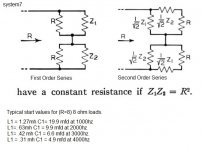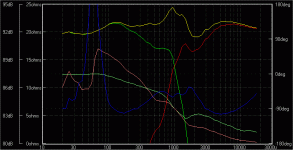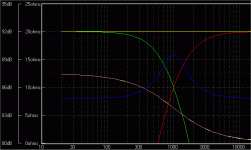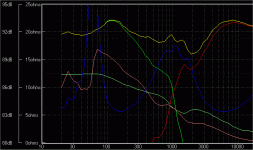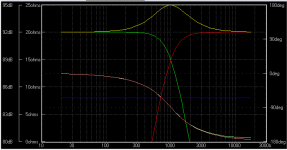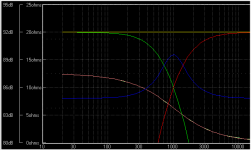Sorry system7, but while have nothing for or against series x-o's your examples with resistive loads and no consideration of the drivers' acoustic responses are not useful, whether for series or parallel configurations. Such circuits appear in Audio back in the '70s. History, history, history. History really does repeat itself.
One word of advice with inductors. Air core a must and doing a subwoofer with true sub drivers will be expensive using 8 ohm drivers.
14-10 gauge wire is required . Most subs need to be padded down a little to mate with satellites.
I am sure Jerry at Falcon can supply U.K. users with any value needed.
Solen has the best price in North America for Canadian and U.SA. builders.
Back in the early 90's Solen was the only vendor I could find that had 12mh 14 gauge air core inductors.
Air-core on a sub? Yeah, right. SuperQ from Erse would be better utilized for a subwoofer.
Also- you don't pad woofers. It changes the Qes in certain ways that are not positive or beneficial.
I still like both PXO and SXO.
Later,
Wolf
PS- I thought I was done...
Maybe thats the problem, I'm just not a first order network guy.
I tried messing around in PCD and can't get past the fact that
the woofer lowpass and tweeter highpass are tied together.
David S.
Hi,
Its only in certain circumstances a 1st order series is
suitable or preferable over a 1st order parallel. The
"zeta" value determines the amount of overlap.
A 1st order FAST is a good example.
rgds, sreten.
Sorry system7, but while have nothing for or against series x-o's your examples with resistive loads and no consideration of the drivers' acoustic responses are not useful, whether for series or parallel configurations. Such circuits appear in Audio back in the '70s. History, history, history. History really does repeat itself.
Hi, Rendering " a very precisely valued second order series crossover" pointless, rgds, sreten.
FWIW I find a series x/o pretty useless for 2nd order electrical in all respects.
I can't think of a single case where it might be useful over a parallel set up.
Whatever the final acoustic targets of the x/o are.
1st order series has components in parallel with the drivers and 1st parallel
has components in series with the drivers. For second order both types
have both, I prefer the last component to be in parallel = 2nd order parallel.
For real drivers and real problems (2nd order electrical and 4th order L/R
acoustic) series x/o's are a nightmare, try coming up with a series
arrangement of this 2nd order electrical 4th order L/R acoustic x/o :

http://www.zaphaudio.com/BAMTM.html
Last edited:
Air-core on a sub? Yeah, right.
But wouldn't 35lbs of dinner plate sized 12 awg air core inductor be just the thing to sooth the ache of having a non maxed out credit card?
"Whoa, is that a Variac from the 50's?" "No, that's my subwoofer crossover."
😉
I used to think the soda can sized Solen caps were pretty neat, too.
Maybe Wolf-teeth can tell the many other Fried inspired builder on Audioasylum that they are also wrong. Here we go again the crossover plans are wrong.
The sub drivers used have a higher sensitivity then the mid bass drivers. The subs would be playing to loud compared to the satellites.
One example in a early Fried design that was in parallel used 15mh air core coil.
http://homepage.mac.com/planet10/TLS/classics/friedH/images/fried-H-xo-map.gif
The sub drivers used have a higher sensitivity then the mid bass drivers. The subs would be playing to loud compared to the satellites.
One example in a early Fried design that was in parallel used 15mh air core coil.
http://homepage.mac.com/planet10/TLS/classics/friedH/images/fried-H-xo-map.gif
I guess Wolf-teeth did not read all the prior posts or links.
I guess Von Schweiikert, Reynaud, some of the Sonus Faber speskers, some of the Totem speakers, Meadowlark designs are wrong that use series crossovers.
I guess Von Schweiikert, Reynaud, some of the Sonus Faber speskers, some of the Totem speakers, Meadowlark designs are wrong that use series crossovers.
I guess Dr Dyna never saw a 12mh 14 gauge air core coil. It does not weigh 35 pounds.
It also is not the size of a dinner plate.
I have also been told many of my Fried t-line encllosure plans are wrong.
It also is not the size of a dinner plate.
I have also been told many of my Fried t-line encllosure plans are wrong.
I guess Dr Dyna never saw a 12mh 14 gauge air core coil. It does not weigh 35 pounds.
It also is not the size of a dinner plate.
I have also been told many of my Fried t-line encllosure plans are wrong.
Of course, I'm being facetious. It's all in good fun!
This may just as well cause an increase in woofer output around the cone break-up region to fill in for the reduced tweeter output. It may even flip over the other way down at the tweeter Zpeak.There are differences that can be regarded as pluses in some cases.
The low pass is quasi second order for series due to the bass drivers
inductance, the same inductance that causes 1st order parallel low
pass to be a shelving circuit,
Sure, but what haven't we done already? I normally use idealised responses and impedances where possible to remove potentially misleading information.Get loose on these circuits with pure 8 ohm resistances rather than real-world drivers, AllenB!
By the way, I think using 8 ohm resistors in sims, and then making practical determinations from the outcomes could be useful if it is remembered that we'd need to conjugate the drivers first. This would surely lose some of the potential audience.
Last edited:
The sub drivers used have a higher sensitivity then the mid bass drivers. The subs would be playing to loud compared to the satellites.
Then use a higher-DCR coil to bring down the low bass range instead of actually padding it and ruining the electrical damping the drivers have inherently out of the box.

Here we go again the crossover plans are wrong.
At least you admit it.
Wolf
The resistance of the inductors are included in the crossover calculations.
I do did not say the crossover plans are wrong.
You have said they are wrong wolf-teeth
.
If you would look at the links. Fried used a 15mh coil in one older design.
There are 2 crossover plans for some of the same subs.
Planet10 put the model H crossover plans on the inernet.
14 gauge air core are called for in all the Fried subwoofer plans.
How can a person comment on a drivers crossover without knowing the drivers specs.
I do did not say the crossover plans are wrong.
You have said they are wrong wolf-teeth
.
If you would look at the links. Fried used a 15mh coil in one older design.
There are 2 crossover plans for some of the same subs.
Planet10 put the model H crossover plans on the inernet.
14 gauge air core are called for in all the Fried subwoofer plans.
How can a person comment on a drivers crossover without knowing the drivers specs.
Originally Posted by system7:
Get loose on these circuits with pure 8 ohm resistances rather than real-world drivers, AllenB!
Sure, but what haven't we done already? I normally use idealised responses and impedances where possible to remove potentially misleading information.
By the way, I think using 8 ohm resistors in sims, and then making practical determinations from the outcomes could be useful if it is remembered that we'd need to conjugate the drivers first. This would surely lose some of the potential audience.
I'd like you to confirm what I'm finding. With a bit of cunning you don't need conjugates aka impedance correction, as speakerman keeps saying, but no-one is getting it...😉
Attachments
Folks,
I hate to break up all this lovely theorising and petty bickering with some practical experience and I promise to go away again afterwards.
I have for a long time wondered about series crossovers. Some "generic" ones floating about had massive claims but no backup and actually measured horrible when implemented. Whenever I worked on a speaker I tried to find ways to use series XO's for speaker designs I was working on and I never got anywhere with series crossovers.
That is until recently.
My current speakers are 3-Ways that use a "full range" (150mm does not matter which as it's discontinued) plus a ring radiator ribbon and a 270mm woofer. I originally operated these drivers with a "simple" first order parallel crossover and only compensating Voice coil inductance.
Basically, the drivers never really liked to integrate, and running sims even with conjugates to kill the full range resonance never yielded something that I felt would sound better. The drivers as such did not need a lot of EQ (except the ring radiator ribbon), just a smooth crossover without resonances.
I did not want to go up in the order of filters (I feel strongly after more than a fair bit of experience that the worst filters are around 2nd order to 6th order, so for me it is either 1st order or elliptical filters.
In the end it turned out that a 1st order series corssover answers the purpose admirably, using an absolutely "pure" crossover. No conjugates etc on woofer and mid, tweeter only has an RC EQ to correct sensitivity and EQ the drooping HF. The filter is "staggered", that is the LF/MF crossover is "inside" the MF/HF one.
Due to some of the other design choices we effectively get an asymmetric crossover between Mid and Treble (3rd order acoustic HPF on tweeter, 1st order acoustic LPF on the midrange).
The crossover between woofer and mid is a bit more transtitional slope and so neatly fills in the midbass dip caused by the discontinuity between "baffle loss" and "room gain".
Even more surprising (perhaps not?), this speaker wants all drivers with positive polarity AND the impedance, excluding the woofers bass loading peaks is very flat at around 6 Ohm (the DCR of the fullrange drivers voice coil), which makes the speaker a much more friendly load for my no global loop feedback tube amp that the parallel version.
What surprised me most was just how much better the series crossover sounded than the parallel one, even though the measured differences where not all that great (the parallel version needed woofer and tweeter with inverse polarity).
I'd show the measurements and Sims, but they where not part of what I had backed up from my laptop (I keep current/recent work on the desktop and somehow forgot to back up the whole profile folder) when it was nicked a few month back, so I'm afraid you have to take my word and no, I'm not redoing any of this unless we have way too many rainy sundays and not enough projects to play with.
The bottom line, with the right context (drivers that are naturally flat and have sensible operating ranges etc.) the first order series crossover can deliver precisely ALL the hype that has been tagged onto it. It just took me 15+ years to FIND the right context, since first being evangelised about series XO's via the long defunked (I guess) Bass List...
So, series X-Overs are neither magic nor universal panacea, but when they work, boy do they work... 😛
And when they don't work, boy do they ever not work. 😀
In the end, don't be afraid to try controversial things, just do your homework so you don't end up with total lemons.
Ciao T
I hate to break up all this lovely theorising and petty bickering with some practical experience and I promise to go away again afterwards.
I have for a long time wondered about series crossovers. Some "generic" ones floating about had massive claims but no backup and actually measured horrible when implemented. Whenever I worked on a speaker I tried to find ways to use series XO's for speaker designs I was working on and I never got anywhere with series crossovers.
That is until recently.
My current speakers are 3-Ways that use a "full range" (150mm does not matter which as it's discontinued) plus a ring radiator ribbon and a 270mm woofer. I originally operated these drivers with a "simple" first order parallel crossover and only compensating Voice coil inductance.
Basically, the drivers never really liked to integrate, and running sims even with conjugates to kill the full range resonance never yielded something that I felt would sound better. The drivers as such did not need a lot of EQ (except the ring radiator ribbon), just a smooth crossover without resonances.
I did not want to go up in the order of filters (I feel strongly after more than a fair bit of experience that the worst filters are around 2nd order to 6th order, so for me it is either 1st order or elliptical filters.
In the end it turned out that a 1st order series corssover answers the purpose admirably, using an absolutely "pure" crossover. No conjugates etc on woofer and mid, tweeter only has an RC EQ to correct sensitivity and EQ the drooping HF. The filter is "staggered", that is the LF/MF crossover is "inside" the MF/HF one.
Due to some of the other design choices we effectively get an asymmetric crossover between Mid and Treble (3rd order acoustic HPF on tweeter, 1st order acoustic LPF on the midrange).
The crossover between woofer and mid is a bit more transtitional slope and so neatly fills in the midbass dip caused by the discontinuity between "baffle loss" and "room gain".
Even more surprising (perhaps not?), this speaker wants all drivers with positive polarity AND the impedance, excluding the woofers bass loading peaks is very flat at around 6 Ohm (the DCR of the fullrange drivers voice coil), which makes the speaker a much more friendly load for my no global loop feedback tube amp that the parallel version.
What surprised me most was just how much better the series crossover sounded than the parallel one, even though the measured differences where not all that great (the parallel version needed woofer and tweeter with inverse polarity).
I'd show the measurements and Sims, but they where not part of what I had backed up from my laptop (I keep current/recent work on the desktop and somehow forgot to back up the whole profile folder) when it was nicked a few month back, so I'm afraid you have to take my word and no, I'm not redoing any of this unless we have way too many rainy sundays and not enough projects to play with.
The bottom line, with the right context (drivers that are naturally flat and have sensible operating ranges etc.) the first order series crossover can deliver precisely ALL the hype that has been tagged onto it. It just took me 15+ years to FIND the right context, since first being evangelised about series XO's via the long defunked (I guess) Bass List...
So, series X-Overs are neither magic nor universal panacea, but when they work, boy do they work... 😛
And when they don't work, boy do they ever not work. 😀
In the end, don't be afraid to try controversial things, just do your homework so you don't end up with total lemons.
Ciao T
Thanks, Thorsten, an interesting observation. There is something in this series crossover business. It's wading through all the unscientific rubbish (and getting flamed by people living in their Momma's basement...) that is making it hard work! Zeta is about as UNUSEFUL a concept as I have ever encountered. Q is much more straightforward to understand. 🙂
Back with the second-order crossover:
AllenB, the first plot looks like a second order butterworth (Q=0.707) with nice flat impedance but the usual +3dB bump to me, but what happens if you wire it IN PHASE? This is crucial.
The second plot for a tweaked circuit is close to a 2nd order Linkwitz-Riley (Lower Q=0.5) from the -6dB point at crossover. Amplitude response is predictably flat (allpass) but we lose the nice flat impedance, which probably makes it no better than a parallel circuit.
Thanks for doing this work. I need someone to confirm what I'm getting. 🙂
Back with the second-order crossover:
An externally hosted image should be here but it was not working when we last tested it.
AllenB, the first plot looks like a second order butterworth (Q=0.707) with nice flat impedance but the usual +3dB bump to me, but what happens if you wire it IN PHASE? This is crucial.
The second plot for a tweaked circuit is close to a 2nd order Linkwitz-Riley (Lower Q=0.5) from the -6dB point at crossover. Amplitude response is predictably flat (allpass) but we lose the nice flat impedance, which probably makes it no better than a parallel circuit.
Thanks for doing this work. I need someone to confirm what I'm getting. 🙂
Attachments
Hi,
No time to work on your problem, sorry, but a snippet.
The German Eckmiller Coaxial Speaker from the late 1930's used a 2nd order series crossover. It used a 12" cone with a coaxial AND coincident 2" Alu dome loaded by a phaseshield/phaseplug to extend HF.
I suspect that the HF driver was very low Qt (drooping response towards crossover point) and the 12" also had falling response towards the crossover point.
[Correction, alternatively, with the in phase connection (which would cause a dip) the drivers may have a mild rising response towards X-Over filling in the hole]...
The driver had a very linear impedance, including a mechanically damped cone resonance (using flow resistance and grease-pot dampers)... It was designed ground up and elements where tweaked until they gave correct desired results.
Ciao T
Back with the second-order crossover
No time to work on your problem, sorry, but a snippet.
The German Eckmiller Coaxial Speaker from the late 1930's used a 2nd order series crossover. It used a 12" cone with a coaxial AND coincident 2" Alu dome loaded by a phaseshield/phaseplug to extend HF.
I suspect that the HF driver was very low Qt (drooping response towards crossover point) and the 12" also had falling response towards the crossover point.
[Correction, alternatively, with the in phase connection (which would cause a dip) the drivers may have a mild rising response towards X-Over filling in the hole]...
The driver had a very linear impedance, including a mechanically damped cone resonance (using flow resistance and grease-pot dampers)... It was designed ground up and elements where tweaked until they gave correct desired results.
Ciao T
Last edited:
- Status
- Not open for further replies.
- Home
- Loudspeakers
- Multi-Way
- Sreten & Speakerman go at series XOs
